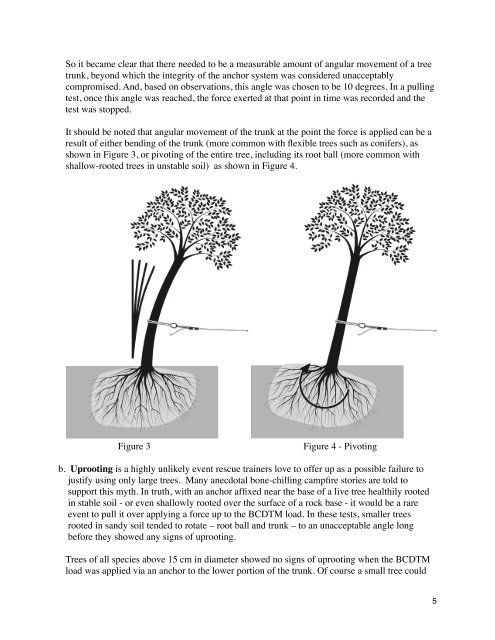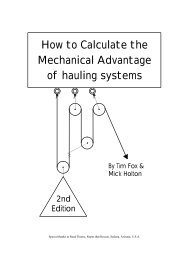How To Determine Tree Strength and Build Tree Anchors
How To Determine Tree Strength and Build Tree Anchors
How To Determine Tree Strength and Build Tree Anchors
You also want an ePaper? Increase the reach of your titles
YUMPU automatically turns print PDFs into web optimized ePapers that Google loves.
So it became clear that there needed to be a measurable amount of angular movement of a tree<br />
trunk, beyond which the integrity of the anchor system was considered unacceptably<br />
compromised. And, based on observations, this angle was chosen to be 10 degrees. In a pulling<br />
test, once this angle was reached, the force exerted at that point in time was recorded <strong>and</strong> the<br />
test was stopped.<br />
It should be noted that angular movement of the trunk at the point the force is applied can be a<br />
result of either bending of the trunk (more common with flexible trees such as conifers), as<br />
shown in Figure 3, or pivoting of the entire tree, including its root ball (more common with<br />
shallow-rooted trees in unstable soil) as shown in Figure 4.<br />
Figure 3<br />
Figure 4 - Pivoting<br />
b. Uprooting is a highly unlikely event rescue trainers love to offer up as a possible failure to<br />
justify using only large trees. Many anecdotal bone-chilling campfire stories are told to<br />
support this myth. In truth, with an anchor affixed near the base of a live tree healthily rooted<br />
in stable soil - or even shallowly rooted over the surface of a rock base - it would be a rare<br />
event to pull it over applying a force up to the BCDTM load. In these tests, smaller trees<br />
rooted in s<strong>and</strong>y soil tended to rotate – root ball <strong>and</strong> trunk – to an unacceptable angle long<br />
before they showed any signs of uprooting.<br />
<strong>Tree</strong>s of all species above 15 cm in diameter showed no signs of uprooting when the BCDTM<br />
load was applied via an anchor to the lower portion of the trunk. Of course a small tree could<br />
5



